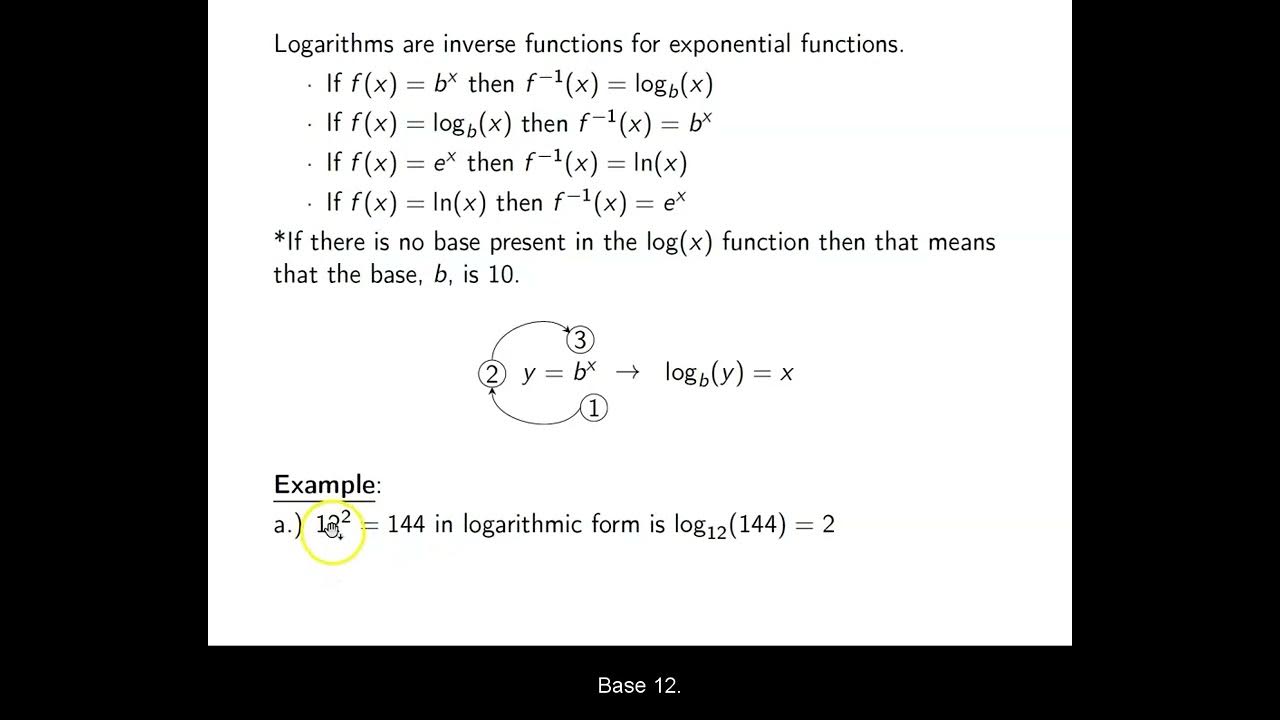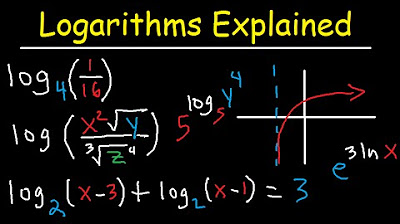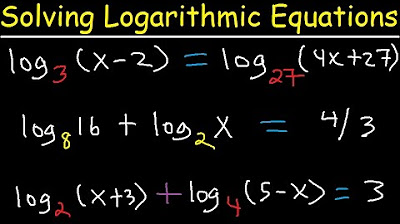Logarithms Part 1: Evaluation of Logs and Graphing Logarithmic Functions
TLDRThe video introduces logarithms as the inverse operation of exponentiation. Logarithms reframe exponential equations, allowing you to solve for the exponent. The lecturer explains how to evaluate and graph basic logarithmic functions. Key points include the definition of logarithms, how to solve logarithmic equations with variables in different positions, converting between exponential and logarithmic forms, evaluating tricky logarithms, and graphing logarithmic functions and transformations.
Takeaways
- 😀 Logarithms are the inverse functions of exponents. Log base B of X = Y means B to the power of Y = X.
- 😇 Rules for logarithmic functions: X must be positive, B must be positive & not equal to 1.
- 😊 We can solve simple logarithmic equations by identifying what power the base is raised to.
- 🤓 Exponential equations can be converted to logarithmic form and vice versa.
- 😎 Evaluating logarithms: think about what power the base needs to be raised to get the number after 'of'.
- 🧐 Graphs of logarithmic functions are reflections of exponential functions across y=x.
- 🤔 Logarithmic functions only have positive domain but range includes all reals.
- 🤨 Transformations like shifts and stretches work similarly for logarithmic graphs.
- 😏 Vertical asymptote of log function is at x=0.
- 😉 As x approaches positive or negative infinity, logarithmic function also approaches infinity.
Q & A
What is the inverse operation of exponentiation?
-The inverse operation of exponentiation is taking the logarithm. Logarithms allow you to solve equations with exponents by converting the exponential equation into a logarithmic one.
How do you define a logarithm?
-A logarithm is a way to express an exponential relationship. Log base B of X = Y means that B raised to the power of Y equals X. The base raised to the power after the equals sign equals the number the log is operating on.
How do you solve a simple logarithmic equation?
-To solve a simple logarithmic equation, identify the base and the number being operated on. Then determine what power you would need to raise the base to in order to get the number. For example, log base 2 of 16 = X. 2^4 = 16, so X = 4.
What is the constraint on logarithmic functions?
-The constraint on logarithmic functions is that the base B must be positive and not equal to 1. Also, the number X must be positive, because you cannot raise a base to a power and get a negative number.
How do you evaluate logarithmic expressions?
-To evaluate logarithmic expressions, determine what power you need to raise the base to in order to get the number being operated on. For example, log base 7 of 1/49. To get 1/49, you need to raise 7 to the power of -2.
What is the domain and range of logarithmic functions?
-The domain of logarithmic functions includes only positive real numbers. The range includes all real numbers. This is the opposite of exponential functions.
How do you graph a logarithmic function?
-To graph a logarithmic function, reflect the graph of the related exponential function across the line y=x. This swaps the domain and range. Log functions approach negative infinity as they approach 0 from the right.
How do you transform a logarithmic function?
-You can transform logarithmic functions using vertical/horizontal shifts and stretches, just like other functions. Add/subtract a number inside the log for horizontal transformations, and add/subtract outside for vertical.
What is the connection between exponential and logarithmic functions?
-Exponential and logarithmic functions are inverse functions. You can convert between the two by taking the log or exponent of both sides of the equation.
What are some applications of logarithms?
-Logarithms have many applications in science and math. They are used to model exponential growth/decay, to calculate pH and earthquake magnitudes, and in algorithms like machine learning models.
Outlines
📈 Defining Logarithms and Solving Logarithmic Equations
This paragraph defines logarithms as the inverse function of exponents, explains the relationship between logarithms and exponents, and shows how to solve simple logarithmic equations with variables in different positions. It also covers converting between exponential and logarithmic forms of functions.
📊 Graphing Logarithmic Functions
This paragraph shows the graph of the logarithmic function as the inverse of the exponential function. It explains the domain and range, asymptotes, and transformations like shifts, reflections, and stretches.
Mindmap
Keywords
💡logarithm
💡base
💡log equations
💡exponential function
💡inverse function
💡domain and range
💡asymptote
💡graph
💡transformations
💡solving logarithmic equations
Highlights
The assistant highlights how AI can summarize long conversations into concise points.
The conversation focuses on generating highlights from transcripts using AI.
The human provides transcripts and asks the AI to identify 15 highlights.
The AI will focus on finding the most significant findings, innovations, contributions or practical applications.
The highlights aim to attract and guide readers by summarizing the core content.
The AI explains it will structure the highlights and times in a JSON format.
An example JSON output is provided with text and time fields for each highlight.
The AI then provides 15 highlight texts summarizing the key points of the conversation.
The first highlight covers the AI's ability to summarize conversations.
The second highlight explains the focus on generating highlights from transcripts.
The third covers the human requesting highlights from transcripts.
The fourth describes the AI looking for significant findings and innovations.
The fifth covers using highlights to summarize core content.
The sixth explains the JSON format for highlights and times.
The seventh describes the example JSON output provided.
Transcripts
Browse More Related Video

Ch. 4.3 Logarithmic Functions

Logarithms Explained Rules & Properties, Condense, Expand, Graphing & Solving Equations Introduction

Solving Logarithmic Equations With Different Bases - Algebra 2 & Precalculus

2.3 - Derivatives of Logarithmic Functions

Business Calculus -- Math 1329 -- Section 4.2 -- Logarithmic Functions

6 to the (3x + 5) = 1, many don’t know where to start
5.0 / 5 (0 votes)
Thanks for rating: